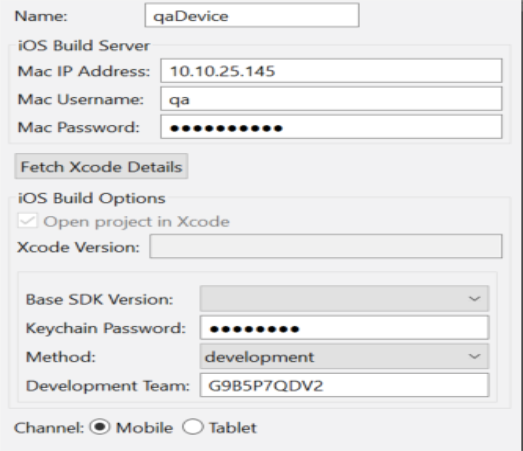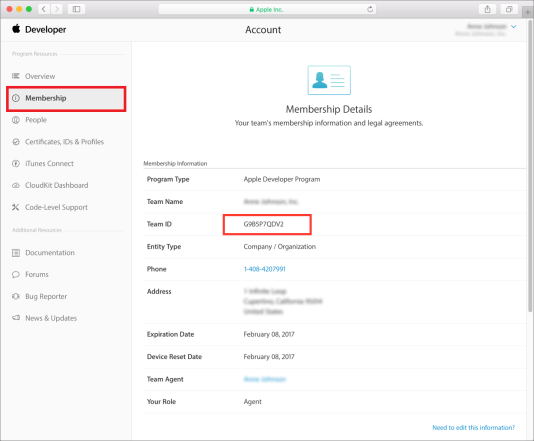Generate Automatic Output for iOS
Applies to Kony Visualizer Classic.
In addition to creating iPhone and iPad applications directly from source code, you can use Kony Visualizer to build an iPhone or iPad application and deploy it to a Mac automatically. You need a dedicated Mac to enable creation of iPhone and iPad application binaries.
Important: Currently, Kony Visualizer supports Xcode 9.0 and later.
Prerequisites
Before you begin, ensure the following conditions are met:
- Xcode and command line tools are installed on the Mac.
-
Xcode path is set to
/Applications/Xcode.app/Contents/Developer/.To check the Xcode path or modify the path:
- Open the Terminal.
xcode-select --print-pathOutput must be:
/Applications/Xcode.app/Contents/Developer/ - If the path is not set, enter the following command:
sudo xcode-select --switch /Applications/Xcode.app/Contents/Developer/
- Open the Terminal.
-
You must have a valid Apple developer account, and you must be signed in to the Accounts section of XCode Preferences.
- Kony Visualizer iOS plug-in must be available in plugins or dropins folder.
- You must have obtained a 10-digit development team identifier from Apple. The Team ID can be found in the Membership Details of your Apple Developer account.
IPA Generation
Building an iPhone or iPad application and deploying it to a Mac involves generating an archive file, and then exporting the archive file to an IPA file based on the specified distribution method.
To enable automatic builds for iOS:
- In Kony Visualizer, on the Window menu, click Preferences.
- From the navigation pane on the left, double-click Kony Visualizer to display its options, double-click Devices, and then click iOS.

- Under the iOS Build Server area, specify the following:
- Mac IP Address/Name: The IP address or domain name of the Mac system in which you want to remotely build and view your application.
- Mac Username: The user name of the Mac system you want to remotely access to build your application.
- Mac Password: The password of the Mac system you want to remotely access to build your application.
The Open project in Xcode option is enabled by default. Xcode opens automatically when you create an IPA in Visualizer Enterprise.
- Specify values for the following:
- Base SDK Version: The Base SDK version on which the device runs.
- Keychain Password: The Keychain password for your application. On the iPhone, Keychain rights depend on the provisioning profile used to sign your application. Ensure that you consistently use the same provisioning profile across different versions of your application.
- Method: The application's distribution method. The method can be one of the following:
- development: Signs and packages the application for development distribution outside the iOS App Store.
- app-store: Signs and packages the application for distribution in the iOS App Store.
- ad-hoc: Signs and packages the application for ad-hoc distribution outside the iOS App Store.
- enterprise: Signs and packages the application for enterprise distribution outside the iOS App Store.
An archive file is always generated initially using development code signing. Xcode then automatically generates the required development provisioning profiles. For development code signing, you must have a valid development certificate installed in your keychain.
When exporting the archive to an IPA using the development option, Xcode reuses the development certificate and provisioning profile that are used for archive code signing. It is unnecessary to create profiles from the development center and install them on your system.
For app-store, ad-hoc, and enterprise options, make sure you have a valid developer certificate, distribution certificate, and distribution profile installed on your system. Xcode will not automatically generate these distribution profiles.
- Development Team: Your 10-digit development team identifier obtained from Apple. The Team ID can be found in the Membership Details of your Apple Developer account.

- Click Save.
- Click OK.
- Build your application for iPhone or iPad.
Note: All errors, warnings, and confirmations can be seen on the Console.
- Generate the IPA file.
Important: You must click Save to apply your changes. If you click OK or navigate to another location in the Preferences dialog box without first clicking Save, any changes you made will be lost.
| Copyright © 2013 Kony, Inc. All rights reserved. |
